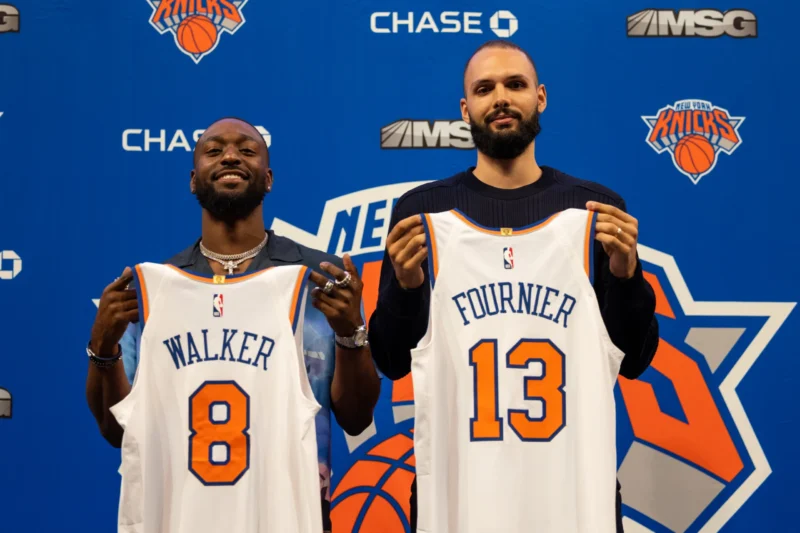NBA Library
Understanding Restricted vs Unrestricted NBA Free Agents
We are helping you understand the difference between unrestricted and restricted NBA free agents. Common terms used in the NBA.

The world of NBA free agency can be a complex and confusing one. It’s full of rules and regulations that govern player movement. One key concept that every fan should understand is the difference between unrestricted vs restricted NBA free agents. These terms may seem simple on the surface, but there are a number of subtleties and nuances. Without understanding them, they can have a significant impact on a player’s career and a team’s strategy.
With all that said, let’s look at the terms and discuss the difference between unrestricted vs restricted NBA free agents.
What to know about unrestricted vs restricted NBA free agents
Unrestricted NBA free agents
What is an unrestricted free agent in the NBA? An unrestricted free agent (UFA) can sign with any team, providing flexibility. In contrast, a restricted free agent (RFA) can sign offers from other teams, but their current team has 48 hours to match the offer, exerting control. Learn the nuances and impact on player movement and team strategy in this guide to navigate NBA free agency effectively.
Now there are some caveats here. Some players may have team options attached to their contracts that prevent them from moving, but for the most part, if an unrestricted free agent signs elsewhere they are free to move.
For Example:
In the recent signing of Jalen Brunson, the New York Knicks agreed on a 4 year $104 million with Brunson. Previously with the Dallas Mavericks, he was an unrestricted free agent because his previous 4 year $6.14 million contract expired. Since the Mavericks did not hold a team option, Brunson was free to sign with any team he wished.
Prior to signing with the New York Knicks, he rejected a $55.5 million contract extension after the trade deadline, per ESPN.
Restricted NBA free agents
What is an NBA restricted free agent? A restricted free agent (RFA) can sign an offer sheet with any team, but their original team can keep them by matching the offer within 48 hours. This is called the “right of first refusal.”
For Example:
This offseason, the Phoenix Suns DeAndre Ayton was involved in this very situation. After becoming an RFA, he agreed to a 4 year $132.93 million max Offer Sheet with the Indiana Pacers. The Suns had 48 hours to match this offer, which they did.
Deandre Ayton signed a 4 year $132.93 million contract with the Phoenix Suns, fully guaranteed. He will become an unrestricted free agent in 2026, per Spotrac.
Can a restricted free agent become unrestricted?
A restricted free agent can become unrestricted in the NBA. If a restricted free agent signs an offer sheet with another team and their current team chooses not to match the offer, the player becomes an unrestricted free agent and is free to sign with any team. Additionally, if a restricted free agent does not receive a qualifying offer from their current team, they also become unrestricted.
How does a player become a restricted free agent?
The first step to become a restricted free agent, is for the players current team to submit a qualifying offer to the player. The qualifying offer must be submitted between the day after the last game of the NBA Finals and June 29.
Once the qualifying offer has been signed, there are three ways an NBA player can become a restricted free agent.
- Following the fourth year of rookie “scale” contracts for former first-round Draft picks.
- For all veteran free agents who have been in the NBA for three seasons or less.
- A player coming off a two-way contract was on an NBA active or inactive roster for at least 15 days in the season beforehand.
Difference between an unrestricted free agent and a restricted free agent
The difference between unrestricted vs restricted NBA free agents is that unrestricted free agents (UFA) are able to sign with any team and accept any team offer sheet. Whichever team offers the best contract and situation can be chosen.
Restricted free agents are a little more complicated. The player can sign with any team, but the player’s existing team can match the offer and force them to stay, regardless of how the player feels about it.
Qualifying offers in the NBA
What is a qualifying offer in the NBA? A qualifying offer is a one-year, fully guaranteed contract offered by a player’s original team. If accepted, the player will play the next season under those terms and become an unrestricted free agent afterwards. This usually happens when other teams do not offer the player more lucrative deals. Players may choose to accept the qualifying offer as a “show them” contract and aim for better offers the following year.
For example, Deandre Ayton completed his four-year rookie contract in 2022 and the Suns extended him a $16.4 million qualifying offer. This made him a restricted free agent and ultimately he was offered $132.93 million by the Pacers which he accepted and the Suns matched.
Team and player options
A contract option allows either the team or player to extend the contract for an additional year. A team option gives the team the right to keep the player for another year, if the team chooses not to exercise it, the player becomes a free agent. A player option gives the player the right to sign with the team or become a free agent.
Related: Legends of the Garden: Exploring the new York Knicks Career Leaders
Related: Carmelo Anthony’s Net Worth: The underrated businessman of the NBA











